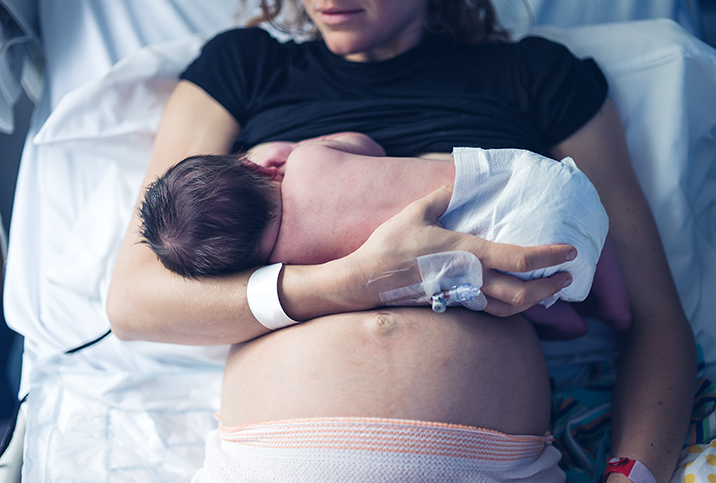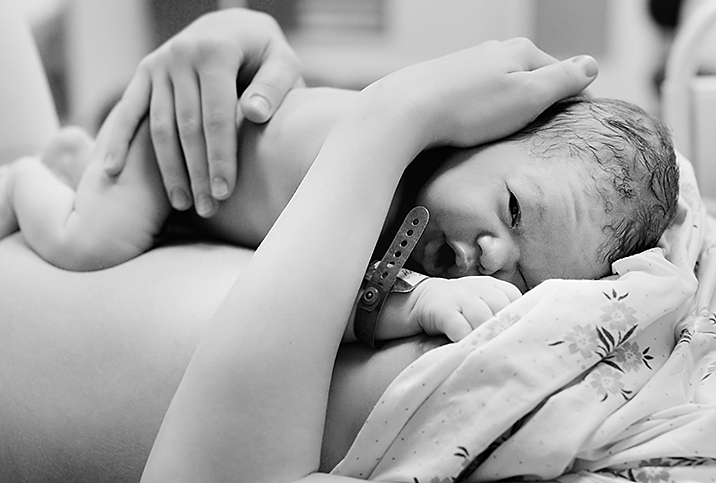Elective Labor Induction Has its Risks

For pregnant people who work a demanding schedule, need to arrange child care, live far from a hospital—or want someone in particular to be present—elective labor induction might be tempting. But as with any medical procedure, it comes with some serious risks.
Here's what you need to know before deciding to induce.
What does labor induction entail?
Whether medical or elective, an induction of labor involves preparing the cervix and stimulating uterine contractors.
"Labor inductions can start with cervical ripening to 'soften' the cervix, and then medications are given to cause contractions to actually start the labor process," said Sarah Yamaguchi, M.D., FACOG. "Cervidil, misoprostol, a cervical ripening balloon are the methods of cervical ripening. Labor itself is induced with Pitocin."
Pitocin is a synthetic version of the hormone oxytocin, which the body naturally produces during labor to stimulate uterine contractions, explained Kiarra King, M.D., FACOG, OB-GYN. Doctors may also use it after the delivery to help the uterus contract down, thereby minimizing uterine bleeding.
"Other ways to induce labor that don't involve medications include membrane stripping/sweeping and amniotomy (artificially rupturing the amniotic sac)," King said. "The latter is usually used in conjunction with or after Pitocin has been started."
When is it safe to induce?
There are several medical reasons an obstetrician might need to intervene, including conditions like preeclampsia, intrauterine growth restriction or premature membrane rupture, which can make it too risky to wait for Mother Nature.
According to the American College of Obstetricians and Gynecologists (ACOG), about 22 percent of pregnant people in the United States undergo induction of labor. Approximately 1 in 10 to 12 inductions is elective.
"If it is safer for the baby/babies to be outside mom than inside, then we induce labor," Yamaguchi said.
ACOG suggests doctors and patients may consider elective labor induction at 39 weeks if it is a first full-term pregnancy, there's a single fetus, and the parent and fetus are healthy.
"If mom or baby's health is at risk, induction before 39 weeks might be recommended. However, unless there is a valid reason, inductions shouldn't be done before 39 weeks," said Nita Landry, M.D., an OB-GYN and "The Doctors" co-host and contributor, who goes by Dr. Nita.
The risks of induced labor
Most induced labors go smoothly, especially for first-time parents. But complications can arise.
According to the Mayo Clinic, risks include:
- C-section: About 25 percent of first-time mothers and 30 percent to 40 percent of all who are induced ultimately require a C-section. This is most common when the cervix is unripe.
- Uterine rupture: Rarely, in people who've had prior C-sections or major uterine surgery, the uterus tears open along the scar line. This requires an emergency C-section and sometimes uterine removal.
- Low heart rate: The use of oxytocin and prostaglandin in labor induction might cause the uterus to contract too quickly, which is called uterine tachysystole. This can reduce the baby's oxygen supply and heart rate.
- Bleeding after delivery: Postpartum hemorrhage can occur if the uterus doesn't contract properly after birth, a phenomenon known as uterine atony.
- Infection: Some induction methods, like membrane stripping/sweeps, can increase infection risk.
"Induction of labor is a medical intervention into a physiological process, where sometimes the benefits outweigh the negatives—but entering into that without proper understanding of the implications is of concern to me as a midwife," said Hannah O'Sullivan, senior NHS midwife & resident midwife at The Positive Birth Company.
O'Sullivan said another risk is an increased likelihood of instrumental birth, or one involving the use of tools like forceps or a vacuum to deliver the baby. This may be necessary because, when labor is induced, the baby may stay in a position that makes it difficult to travel down the birth canal. Contractions may also be more painful, increasing the need for an epidural, which can make it difficult for the patient to push effectively.
Jaundice, wherein the liver can't break down red blood cells effectively, is another potential complication. The condition isn't uncommon in newborns, whose livers are sometimes not sufficiently developed, and it is treatable. However, it may mean a longer hospital stay for parent and baby.
'If it is safer for the baby/babies to be outside mom than inside, then we induce labor.'
"Preexisting medical conditions can increase the chance of some of these [complications] happening too, but there is plenty of evidence to show that these outcomes are more common in induced labors than they are in spontaneous labors—hence the need to be fully informed about all the positives and negatives before making a choice," O'Sullivan said.
To diminish risks, practitioners use continuous electronic fetal monitoring to assess how the baby is handling the stress of labor induction. By contrast, ACOG recommends intermittent, rather than continuous, fetal monitoring for spontaneous, low-risk pregnancies.
Do doctors recommend elective labor induction?
The medical community is divided as to whether elective inductions are a good idea or not. But most say it is generally safe for those with a healthy pregnancy and favorable cervix and obstetric history.
King cited a recent study, The Arrive Trial, published in 2018 in the New England Journal of Medicine, that supports the safety of elective inductions for healthy first-pregnancy patients without concern for increased risk of C-section. Even so, she said, it isn't right for everyone, even those in the low-risk group.
"In general, we do not recommend elective inductions, but we would recommend medically indicated inductions," Yamaguchi said.
"There are risks associated with any medical procedures," she continued, "but if a patient is willing to take on those risks and understands them, then it is up to the patient as long as it is [in] the realm of medically acceptable."


















